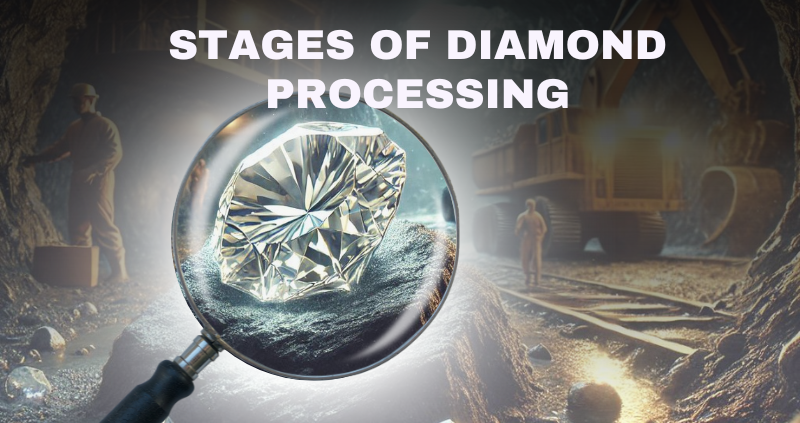Crafting Brilliance: Exploring the Key Stages of Diamond Processing

Diamonds are among the most sought-after gemstones, However, before they adorn the finest jewellery, diamonds undergo a meticulous and fascinating journey from rough stones to brilliant gems. This blog post will delve into the stages of diamond processing, answering key questions and shedding light on the importance of each step.
What is Diamond Processing?
Diamond processing refers to the series of steps involved in transforming a rough diamond from its natural state into a polished gem suitable for use in jewellery. This process includes extraction, cutting, polishing, and grading, each stage requiring precision and expertise to maximise the diamond's inherent beauty and value.
What are the Steps in Diamond Making?
- Exploration and MiningThe diamond journey begins with exploration and mining. Geologists use various methods to locate diamond-rich areas, often in regions with ancient volcanic activity. Once a potential site is identified, mining operations commence. There are two main types of diamond mining:
- Open-pit mining: Suitable for diamond deposits near the earth's surface.
- Underground mining: Employed for deeper diamond deposits.
In both methods, large amounts of earth and rock are excavated and transported to processing plants.
- Crushing and Milling: The mined ore undergoes crushing and milling to break it down into smaller pieces, making it easier to extract the diamonds. Crushing reduces the ore to manageable sizes, while milling further grinds it into a fine powder.
- Concentration: This step involves separating the diamond-containing material from the rest of the ore. Several techniques are used, including:
- Dense Media Separation: Using a fluid with a density that allows diamonds to sink while other minerals float, making separation more efficient.
- X-ray Fluorescence: Diamonds emit fluorescence when exposed to X-rays, which helps in their identification and separation from other minerals.
4. Recovery: After concentrating the material to isolate diamond-rich portions, the recovery process extracts the diamonds. This is usually achieved through:
- Grease Tables or Belts: Diamonds naturally adhere to grease, allowing them to be collected on surfaces while other materials are washed away.
5.Sorting and Valuation: Recovered diamonds are sorted by size, shape, quality, and colour. This stage is crucial for determining the potential value and optimal use for each stone. High-quality diamonds are earmarked for cutting and polishing, while lower-grade diamonds may be used for industrial purposes.
6.Cutting and Polishing: Cutting and polishing transform rough diamonds into sparkling gems. This stage is both an art and a science, aiming to maximise the diamond's brilliance and fire. The key steps include:
- Planning: Using an advanced software to map the rough diamond and determine the best cut.
- Cleaving or Sawing: Splitting the diamond along its natural grain using lasers or diamond saws.
- Bruting: Shaping the diamond into a round form.
- Faceting: Adding and polishing facets to enhance the diamond's brilliance. Typically, a standard round brilliant cut has 57 or 58 facets.
7. Grading and Certification: Polished diamonds are graded based on the Four Cs: Carat weight, Cut, Colour, and Clarity. Independent gemological laboratories, such as the Gemological Institute of America (GIA), provide certification that verifies these characteristics. Grading ensures transparency and confidence for buyers.
The Crucial Importance of Every Stage in Diamond Processing
Processing a diamond through all these stages is crucial for several reasons:
- Maximising Value: Each step in the diamond processing chain adds value to the stone. Proper cutting and polishing, for example, can significantly enhance a diamond's brilliance, making it more desirable and valuable.
- Ensuring Quality: Comprehensive processing ensures that only the best-quality diamonds reach the market. Substandard stones are filtered out or redirected for industrial use.
- Consumer Confidence: Certification from reputable labs assures buyers of a diamond's quality and authenticity, fostering trust in the product and the seller.
- Sustainable Practices: Modern diamond processing emphasises ethical and sustainable practices. From responsible mining to fair labour standards, each stage can be monitored and improved to ensure minimal environmental impact and better working conditions.
Additional Important Information
.~Ethical and Sustainable Practices in Diamond Processing
The diamond industry has made significant strides in adopting ethical and sustainable practices. Initiatives like the Kimberley Process Certification Scheme (KPCS) aim to eliminate the trade of conflict diamonds, ensuring that diamonds entering the market are sourced responsibly. Consumers are increasingly aware and concerned about the origins of their diamonds, making ethical considerations a vital part of the processing stages.
Technological Advancements
Technological advancements have revolutionised diamond processing. From laser cutting to sophisticated imaging for grading, technology enhances precision, efficiency, and accuracy at every stage. Innovations continue to push the boundaries of what is possible, allowing for even more exquisite diamond cuts and higher standards of quality.
The Role of Artisans
While technology plays a significant role, the expertise and artistry of skilled artisans remain irreplaceable. Master cutters and polishers bring decades of experience and a keen eye for detail to the process, ensuring that each diamond is crafted to perfection.
Conclusion
The journey of a diamond from rough stone to sparkling gem is a complex and meticulous process involving multiple stages. Each step, from mining and recovery to cutting, polishing, and grading, is crucial in maximising the diamond's value and ensuring its quality. As consumers, understanding these stages not only enhances our appreciation for these timeless gems but also underscores the importance of ethical and sustainable practices in the diamond industry. Whether you're a buyer, a seller, or simply a diamond enthusiast, knowing the intricacies of diamond processing enriches your knowledge and deepens your connection to these extraordinary stones.
Welcome to GA Demands, where buyers and sellers connect to trade diamonds online. Our platform not only facilitates diamond transactions but also aims to educate and inform our community about the fascinating journey of diamonds. In this blog, we delve into the "Stages of Diamond Processing," uncovering the meticulous steps that transform rough diamonds into the sparkling gems you cherish.

